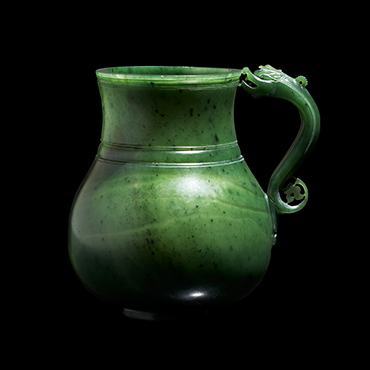So thin that light shines through
Since the 11th century, jade has been associated with the Turkic peoples of Central Asia, with scientist and thinker Al-Biruni (AH 362–439/973–1048 CE) describing it as the “victory stone” which the Turks used to decorate their arms and armor. The association between jade and power continued under the Mongols and their successors, the Timurids, who ruled over much of 10th-century AH/15th-century Iran and Central Asia. An outstanding Timurid example, this spectacular white jade jug inscribed with the name of the Timurid ruler Ulugh Beg (r. AH 850–53/1447–9 CE), copied the form of metal drinking jugs, with a globular body, vertical neck, and raised band around the base of the neck. Another jug of the same form, heavily inlaid and gem-set, was made for the founder of the Safavid dynasty, Shah Isma‘il (r. AH 907-30/1501–24 CE).
A number of features suggest that this jug is slightly later than the jade examples described above. The form is more elongated and less closely related to that of globular metal jugs, a development of form that exactly mirrors that documented in 10th-century AH/16th-century Iznik pottery. However, the integrally carved handle demonstrates that the craftsman had all the details of the metalwork forms clearly in mind. Given the exceptional refinement of this carving, a later production date in an established center appears the most probable origin. Support for this attribution is given by further comparison with the majority of Timurid jade jugs and cups of related forms, all of which have a thickly carved body, with drilled and sawn details, giving an impression of ruggedness. In contrast, the body of this jug is finely carved, with small details, such as the palmette at the base of the handle carved with exquisite refinement and delicacy and with side walls so thin that light shines through.
Jug
Iran, Türkiye or Central Asia, AH 905–57/1500–50 CE
Nephrite Jade, h. 11.7 × w. 12.2 cm, 436 g
The Al Thani Collection, ATC221

